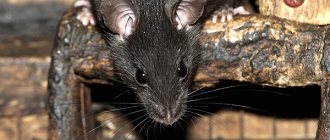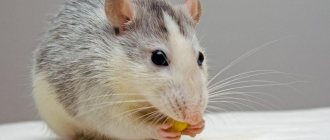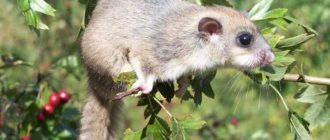European civilization has been familiar with the black rat for much longer than with the gray rat (another name for which is pasyuk). When pasyuks first began to conquer Europe in the Middle Ages, black rats were already the scourge of agriculture and big cities. It was black rats that ancient authors mentioned in their works, that is, the civilized world has known these rodents for several millennia.
Today, after just a few centuries, both in Europe and Russia, the black rat is found less frequently and in smaller quantities than the gray rat. Here, many people may never see representatives of this species in their entire lives, although they huddle next to them in residential buildings, in enterprises and near housing, but in much smaller quantities than Pasyuks.
Below in the photo is a black rat:
And here is a gray rat, or pasyuk:
And if today the pasyuk is, one might say, the main rodent pest in everyday life and in agriculture in Europe, Russia and North America, then black rats are not so noticeable here, and the scale of their wrecking is much smaller. It seems as if the gray brothers are shamelessly pushing the blacks out of nourishing and comfortable lands, leaving them only with what they themselves neglected.
How did it happen that in just a few centuries (not such a long period by evolutionary standards) black rats turned from the main enemy of the national economy in Europe into a pale shadow of their gray brother? And are they really complete outsiders in the merciless competition with the bosses? Maybe their defeat is only apparent?
The answers to these questions lie in the peculiarities of the biology of the species, which let’s talk about in more detail...
Difference in appearance: how is a black rat different from a gray one?
Outwardly, it is not difficult to distinguish a black rat from a gray one, especially if you look at these animals (or at their photographs) at the same time:
- The black rat is smaller and somewhat slimmer, it has a more elongated muzzle;
- The fur color of representatives of this species is darker, corresponding to the name. Although, as we will see later, animals from some populations may have completely different colors;
- The black rat has larger ears - together with a longer nose, they make it look like a large mouse.
The black rat also has unique anatomical features that only biologists know about. For example, the parietal ridges of the skull are arched, while in the Pasyuk they are more even. In living animals of both species this is not noticeable - such details are revealed only when studying the skulls.
It may seem that the main difference between a black and a gray rat is the color of its fur. This assumption is true, but not always. The fact is that the species has several color races, and some of them are even lighter than Pasyuks.
So, for example, in Europe, two races are approximately equally common, one of which has a typical black-brown fur color, darker than that of pasyuks, and the other is almost brown-haired with a white belly, similar in color to gophers. That is, it would be hard to call animals of the second race black, even though they are normal representatives of the species. The species name for them is nothing more than a term to identify the animal.
For example, the photo below shows an individual of the light morph:
The black rat is smaller in size than the Pasyuk. The largest representatives of this species reach a length of 22 cm, their tail is about 29 cm long, and their body weight reaches 300 grams. For comparison: for pasyuks, 300-320 grams for an adult animal is the norm, and individual males can eat up to 400 grams.
On a note
By the way, another important difference between a black rat is that its tail is always longer than its body. In gray, the length of the tail is always less than the length of the body.
Today a very interesting fact has been established: under the name “black rat” there are actually four look-alike species hidden. Outwardly, they are no different from each other, have no anatomical differences, and lead the same lifestyle. But their offspring, when crossed, are less fertile and viable than those of two representatives of the same species. Moreover, due to the fact that such descendants quickly degenerate, and rats from “pure lines” survive, the twin species themselves are constantly separated genetically, although they remain outwardly identical.
However, some scientists do not fully agree with the identification of four separate species of black rats. They only talk about karyotypic forms.
As a result, one of the interesting phenomena with which nature is so rich takes place: the ranges of such twin species can intersect geographically, and in the same territory, outwardly indistinguishable individuals of black rats can live side by side, without producing viable offspring. At the same time, representatives of different color races of the same species, clearly distinguishable from each other (black and yellow), easily interbreed, and their offspring retain fertility and vitality.
This is interesting
The phenomenon of sibling species is widespread in nature. It became known to researchers relatively recently, after the introduction of genetic research methods into practice. Before that, it was impossible to differentiate representatives of such species from each other, since they have no external or anatomical differences. The methods of genetic research made it possible to unambiguously find differences in the genotype sufficient to distinguish animals into different species.
For example, after conducting relevant research, it turned out that the most dangerous species of malaria mosquitoes, Anopheles gambiae, is, in fact, a group of 16 separate species, completely identical in appearance. But black rats turned out to be even more unique: their twin species differ not only in individual genes, but even in the number of chromosomes.
Diseases spread by rodents
Diseases transmitted from rats Scientists are finding out how dangerous rats and mice are in laboratory conditions. During the course of research, it became known that rodents transmit many dangerous diseases:
- plague;
- encephalitis;
- sodoku;
- streptobacillosis;
- rabies;
- typhus;
- fever;
- cryptosporidiosis;
- giardiasis;
- leptospirosis;
- tularemia;
- listeriosis;
- tuberculosis;
- hepatitis;
- salmonellosis;
- toxoplasmosis;
- parasitic diseases, fungal, viral.
Rodent excrement provokes asthma attacks, the development of an allergic reaction, and exacerbation of atopic dermatitis.
Lifestyle and behavioral characteristics
In terms of their way of life, black rats do not stand out much among rodents in general and, in general, are typical rats. They can live in a wide variety of biotopes, quickly adapt to changing living conditions, and colonize both natural and anthropogenic landscapes with approximately equal ease.
They are also characterized by several unique biological features:
- They rarely dig holes. In nature, these animals prefer to settle among stones, in nests in trees, under logs, in cavities between the foundation of a building and the soil layer, including in parks near monuments and fountains. Only in the complete absence of natural shelters can they dig holes for themselves, but in general they are not earthen rodents;
- These animals very willingly live in trees. They are excellent climbers on vertical surfaces and build their own spherical nests from branches, similar to magpie nests. In the tropics, populations of rats are known that for many generations do not descend from the trees to the ground. Moreover, they can live both on coniferous and deciduous trees, including palm trees;
- The black rat is thermophilic; in natural biotopes it lives only within the tropical and subtropical zones. It does not live in central Russia all year round outside human settlements;
- On the contrary, in the tropics these animals actively enter natural biotopes, easily adapt to them and break ties with human habitation. This is how they differ from Pasyuks, who are more attached to humans, and it is due to this that they managed to spread with great speed to many deserted islands of Oceania. In tropical areas around the world, black rats are more numerous and widespread than gray rats;
- Black rats are quite conservative when settling, they are more attached to one place than pasyuki. For this reason, they slowly spread over land, and their range increases mainly due to passive dispersal with human transport. This species was almost always brought to new cities and countries on merchant ships.
It is also useful to read: Why are rats dangerous to people and what diseases do they carry?
Like gray rats, black rats live in small groups, usually family groups, in which there is one dominant male, several main females and individuals located at lower levels of the hierarchical pyramid.
Due to their heat-loving nature outside the tropical zone, black rats do not reproduce during the cold season, even if they live next to humans in heated rooms. This, by the way, is one of the factors due to which black rats are replaced by gray ones - the latter simply reproduce faster.
In general, the black rat prefers to lead a nocturnal lifestyle, but next to a person it quickly adapts to the rhythm of his activity and switches to such daily activity that is most beneficial to it.
Cute dachshund
This story happened in Russia almost 28 years ago. The country's rich people, in search of constant exotic innovations, often got a dachshund dog, which was inaccessible to average Russians.
One day, one woman bought such a dachshund for her family and, as if nothing had happened, walked down the street with it. The dog was very active and mischievous, she constantly ran along the street, sniffed out something and played. Soon children began to gather around the dachshund. She was so kind and affectionate that the owner never worried that her dog could harm others.
What does a black rat eat?
In terms of its gastronomic preferences, the black rat is, so to speak, a greater rodent than the beekeeper. The basis of her diet is plant foods, mainly grains, fruits and vegetables, nuts, and green parts of plants. She does not have such a high need for animal food as the pasyuk, although if possible she will not fail to feast on insects, bird eggs or milk. These animals do not purposefully catch amphibians or, for example, ducklings, which is known for pasyuki.
However, on oceanic islands it is black rats that are the main scourge of birds nesting on the sand or in low bushes. There are several sad examples where these animals led to the complete extinction of entire species simply by destroying their nests and eating their eggs.
In the photo there is a nest destroyed by a rat:
On a note
Populations of ocean birds - albatrosses and petrels - are greatly affected by rats. These species nest in large colonies on remote islands of the Indian and Pacific Oceans, where there are no predators at all. The black rats that appeared here learned to attack chicks right in the nests, gnawing their paws and skin. According to ornithologists, up to 30% of the chicks in the colonies here die precisely because of rats, and this poses a threat to the well-being of the species in general.
There are also examples where black rats, accidentally introduced into new areas, led to a reduction in the populations of large snails, which they constantly hunt.
At the same time, these rodents are very picky about food. Capable of eating different foods, in each specific place of their habitat they choose a diet composition that, on the one hand, ensures a normal balance of nutrients and vitamins, and on the other, avoids the risk of poisoning. In the future, the animals disciplinedly adhere to the chosen diet.
Partly for this reason, black rats are difficult to destroy with the help of poisons - the animals are not particularly willing to taste new foods, including poisoned baits.
In addition, black rats are generally more resistant to poisons than pasyuki.
One animal eats about 15 grams of food per day and drinks about the same amount of water. In general, in nature, black rats are less dependent on open sources of water than their gray counterparts.
Who is most susceptible to attacks?
Rats are smart and even smart animals (it’s not for nothing that they manage to survive in the most unfavorable conditions), so most often they attack those they consider weak prey. And therefore, children, old people, sick and weakened people suffer more. In addition, prisoners often become victims of rats (there are a lot of rats in prisons, and they often try to take food from prisoners), homeless people living in rat habitats and disturbing them, as well as alcoholics.
Rats do not attack people often, but such cases do occur.
Sources
- https://krot911.ru/krysy/o-krysax/napadayut-li-krysy-na-lyudej.html
- https://eparazit.ru/mozhet-li-krysa-napast-na-cheloveka.html
- https://stopvreditel.com/gryzuny/myshi-i-krysy.html
- https://apest.ru/krysy/vse-o-krysah/chem-opasny-krysy-dlya-cheloveka/
- https://petse.ru/gryizun/myish_krys/napadayut-li-krysy-na-lyudej.html
[collapse]
Habitat
The black rat is distributed almost throughout the world; it is not found only in Antarctica and the Far North. However, its range in many places is very fragmented; in some places these animals are very rare or are not found outside human habitation.
For example, in Russia, the black rat is strictly attached to cities; it settles on agricultural lands only with regular crop rotation; it does not penetrate into the wild nature in the temperate zone and has no effect on it. But in the subtropics - in the Caucasus and Crimea - wild populations of this species are known, not associated with human habitation. Scientific research shows that black rats lived here long before humans appeared and are a relict species.
Interestingly, the vast majority of black rat populations in temperate climates are concentrated in port cities. This is due to the fact that the animals themselves willingly settle on river and sea vessels, but do not move far on land; their passive settlement with cargo predominates here.
Having accidentally found themselves in a new city, the animals settle there and become numerous, but do not expand their presence in the region. For example, in Great Britain, black rats inhabit port cities in the largest numbers, while gray rats “capture” the interior areas. In another example, several thousand kilometers to the east, in Tatarstan, black rats are most abundant in Kazan and Naberezhnye Chelny, while in villages far from rivers there are practically no such rats.
In general, black rats have a special relationship with water transport. According to statistics, 75% of rodents on any ship are them, and the remaining 25% are beepers and mice. This is mainly due to the preferred diet of animals: pasyuki do not find enough meat on ships, mice here suffer from a lack of grain, and black rats feel at ease on garbage and crackers.
But on the “shore”, black rats exhibit another preference: they gravitate toward heights and dry habitats. You won’t find them in damp basements, nor in sewers, where bastards reign, but they actively populate dry attics, spaces above false ceilings, and the top floors of buildings behind plasterboard partitions. In the old days, they created entire rat cities in the thatched roofs of village huts. For this, by the way, in some places they are called “roof rats.”
In the tropics the situation is different. Here, the black rat actively inhabits natural biotopes, almost any - from semi-deserts and rocky mountain slopes at an altitude of 1500 m above sea level to the jungle of tropical rainforests and mangroves. But it is especially numerous on agricultural lands - in rice fields, fruit plantations, peanut farms.
It is also useful to read: Interesting facts about gray rats (pasyuki)
On a note
In India and China, a natural phenomenon called Mautam, or “death of bamboo,” is known. It is connected with the fact that once every 48 years there is a population explosion of black rats, which takes on the character of an invasion, and millions of animals eat almost all the falling bamboo seeds. Because of this, the bamboo forest does not grow again the next year. Scientists believe that this is a natural process that regulates bamboo populations, although for the Chinese and Indians themselves, such an event is more like an environmental disaster.
But the main feature of the distribution of the black rat is the sharp reduction and fragmentation of its range in Europe over the past few centuries. In many cities the species has become rare, and in some places it has disappeared completely. This is due to many factors - the displacement of black rats by gray ones, and the improvement of means for controlling rodents, and an increase in the general level of sanitation. Moreover, people spend a lot of money on fighting black rats.
Man's old "friend"
The homeland of the black rat is considered to be East and Southeast Asia, from Vietnam to Afghanistan. It appeared in the Mediterranean and the Middle East back in the Pleistocene era, when mammoths trampled the icy tundra of Yakutia, and Neanderthals ruled the territory of modern Spain, Greece and Italy.
This species was the first to begin to inhabit human housing even when the housing itself was simple huts and caves. And as cities developed, rats became more and more “civilized.”
It was black rats that caused the first outbreaks of the plague pandemic in Europe. In nature, settlements of this species are natural reservoirs of the plague pathogen, from here the animals easily carry plague bacilli into cities. Humans are directly infected with the plague by fleas that have previously bitten sick rats.
In general, the most devastating plague pandemics in medieval Europe arose after the invasion of the Pasyuks. However, the townspeople at that time did not particularly distinguish between these two species, and therefore the more familiar black rats for a long time (if not forever) became a symbol of death, unsanitary conditions and “dark” times.
Before the appearance of pasyuks, black rats were the main pests of agricultural supplies throughout Europe and Asia. In German cities, bonuses were given for the destruction of a large number of these pests; there were even days of prayer for getting rid of rodents.
These measures, however, helped little, and even today, being armed with the most effective poisons and ingenious devices, people only manage to keep the number of rats within certain limits with great difficulty. Much more effectively than all poisons and traps, the black rat is suppressed by its closest relative, the pasyuk.
Difficult relationships with relatives, or why black rats retreat
In those cities into which gray rats penetrate, the decline in the number of their black counterparts is very noticeable. Pasyuki seem to drive out relatives, although in reality there is no direct persecution of one species by another, and when they meet, the animals behave quite like neighbors.
The point here is interspecific competition. Where Pasyuki settle, they find and eat food faster and more actively, due to their high activity, they occupy the best and safest shelters, and quickly expand the settlement area. In addition, gray rats are more fertile: they breed all year round, with a female having about 10 cubs in each litter (versus 5 for black rats). Gray rats simply do not leave food or normal shelters for black rats, and the latter more often die from predators or during deratization measures.
By the way, in any city, ecologists note a characteristic picture: large gray rats inhabit the lower floors of buildings, sewers, basements, parks, gardens and vegetable gardens, and the remnants of the population of black rats desperately cling to attics and (if the city has a port) to ships on the water, which pasyuki do not particularly favor their attention.
In the tropics, the situation is the opposite: here the winner in the competition is the black rat, which is more adapted to life on agricultural lands outside human habitation.
At the same time, in their natural habitat, competition between black and gray rats does not arise, since these species occupy different ecological niches. Pasyuki live near water, and black rats live in drier biotopes, as a result they rarely live side by side and they do not have to compete for food resources or places for shelter.
A fact is a fact: today the black rat is considered one of the most numerous and widespread species of animals in the world in general. This means that its “loss” to Pasyuk is local, manifesting itself only in a temperate climate. Having lost here to the gray rat in the fight for human habitation, it confidently wins the competition in the wild in the tropics, and therefore there is no clear winner in this competition yet.
Varieties by body type
The main types of rats differ in body shape, tail length and ear size. The main characteristics are as follows:
- The standard is the most popular type of rat, which is the basis for other body types. Its body is proportional, slender, 20-25 cm long with a tail, which is thicker at the base and tapers towards the end. Females are usually smaller in size than males. The eyes are round and quite large. The ears are round and are located at the top of the head. The coat of standard rats is dense with a beautiful shine; the paws and tail are also covered with thin, short fur.
- Dumbo rats have a pear-shaped body that widens at the back. The name was given for its resemblance to the Disney cartoon character, Dumbo the elephant. They differ from the standard type of rat in the shape and size of their ears: they are located slightly lower, on both sides of the head, wider and rounder, for which they were given the name “eared rats.” In total, there are 2 types of ears: “saucer” with a full opening and “tulip”, when the upper part is slightly curled down like a petal. The Dumbo rat breed is diverse in coat color, and there are also hairless sphinxes. These rats are unpretentious, but are sensitive to sudden changes in temperature and the presence of dust.
- Tailless rats are born without a tail, even its rudiment is missing. This species appeared as a result of an unplanned mutation in 1983. The shape of the body is pear-shaped, the ears are slightly larger than the standard. This species is more difficult to breed because the offspring are often mixed, sometimes non-viable.
Important!
Rats love company, so this needs to be taken into account when purchasing them. If the owner does not have time for long-term communication with his pet, then it is better to have 2-3 individuals at the same time, preferably of the same sex, otherwise in a couple of months the rat family will increase exponentially.
Decorative black rats - are they really black?
And finally, one more interesting nuance: decorative black and black and white rats are domestic forms of the gray rat, and their black fur color was obtained as a result of artificial selection and selection. Since the dark coat color of gray rats dominates over white ones, breeding animals with black tones in color is not difficult, and breeding work with them is relatively quick.
By the way, thanks to the speed of reproduction, numerous breeds of decorative rats have been bred today. For example, in the photo below there is a Rex rat whose fur is slightly curly:
And then in the picture there is the so-called naked rat:
On a note
Tricolor rats are unique in their kind. The fact is that in rats, the gene encoding the presence of a third color in the coloration is not inherited, and therefore such coloring is due only to random mutations. Tri-colored rats are very rare, with only a few known in the world today. Black rats, with which no selection work is carried out, are not tricolored at all.
Real black rats are not kept in captivity; you can buy a decorative rat with a completely black color or individual black spots on the body at a poultry market or pet store.
Interesting video: black rat in its natural habitat
Feeding
Do you want to know what to feed your kitty rat? Everything is quite simple, especially since pets are unpretentious in food.
The rat menu should consist of:
Grain. Experienced owners prepare and select the ingredients for feeding themselves. A ready-made mixture of grains can be purchased at almost any pet store.
Vegetables, herbs and fruits. In small quantities. There is no need for any special products here; common vegetables and fruits are quite suitable for rats. Herbs such as dill and parsley will also suit their taste.
Protein food. A little meat, cottage cheese or cheese. These products are not for your daily diet.










